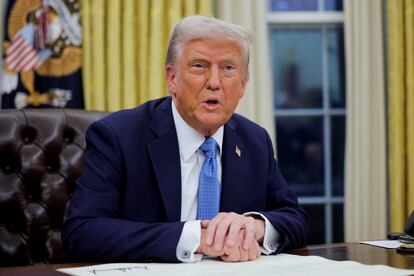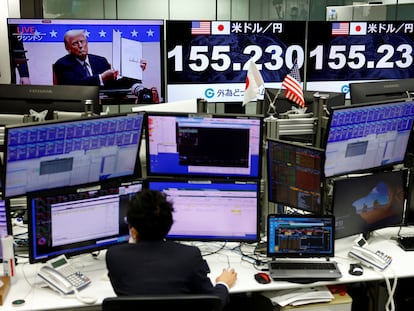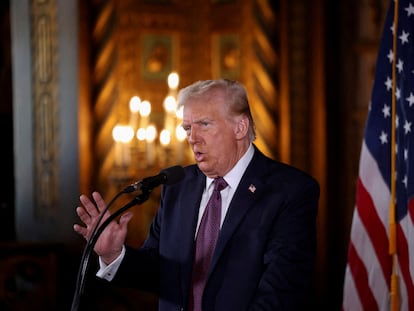Mexico-US relationship faces the worst bilateral crisis in decades
The threat of tariffs by Donald Trump is the latest in a long list of confrontations, from the dramatic debt crisis of the 1980s to clashes over the Iraq war and previous trade battles


“So far from God, so close to the United States.” This phrase, uttered by the Mexican military leader and president Porfirio Díaz at the beginning of the 20th century, comes back with force every time there is a crisis between the two countries, something that has been common during more than two centuries of proximity. The U.S. and Mexico share one of the largest borders in the world, they have highly interconnected economies and a tangle of crossed interests, from the geopolitical to the cultural, that have caused a long list of clashes. All of them quite asymmetrical, with the powerful neighbor to the north almost always holding the best cards.
The latest crisis is a result of the attack by Donald Trump as part of his ultra-nationalist, hardline policies. The new U.S. president has Mexico among his favorite targets, accusing it of being the back door for Chinese imports, of not containing migration across the Rio Grande, and of flooding its streets with fentanyl, the powerful opioid that has caused a deadly epidemic in the U.S. and filled the coffers of organized crime. As punishment — and as a negotiating strategy — he has promised to impose harsh tariffs on Mexico, his top trade partner. The consequences are still difficult to predict with accuracy. But for the moment, it has opened the biggest bilateral crisis in decades.
At the turn of the century, the Iraq war was the trigger for another episode of tension. Then-Mexican president Vicente Fox repeatedly called George W. Bush in 2003 at the start of the war, and it took a considerable amount of time for his calls to be answered. The head of the White House was very busy, but above all he was angry with his ally and rancher friend, of similar profile and background as himself, for rejecting his repeated invitations to join the attack against Saddam Hussein. “We feel deeply disappointed,” declared the then U.S. Secretary of Homeland Security, Tom Ridge.
Trust between Mexico and the United States was broken, according to historian and Harvard University scholar John Womack, author of Zapata and the Mexican Revolution. “Nothing” unites the Fox and Bush governments. “Only the boots they both wear,” the scholar said at the time. For weeks, Mexican legislators were unable to arrange meetings at the Capitol. A judge blocked Mexican sales of tuna in the U.S. and the FBI was ordered to detain irregular migrants at the border indefinitely. As a final touch, Mexico was set to preside over the U.N. Security Council at that time. A year and a half later, after Fox’s visit to Bush’s Texas ranch, relations returned to normal.

The sword of tariffs that Trump is now wielding is not new either. In 2009, the Mexican government of Felipe Calderón threatened to impose tariffs on 90 agricultural and industrial products from its northern neighbor. This was a reprisal for closing the border crossing to a pilot program that gave priority to Mexican cargo trucks, causing million-dollar losses and strong social rejection on the Mexican side. The justification of the White House, then led by president Barack Obama, was a lack of money to implement the plan. But Mexican authorities suspected that there was also a certain fear that the roads would also become clogged with drugs and migrants.
The Mexican tariffs were eventually implemented and remained in force for almost a year, until both governments signed a peace agreement in exchange for comprehensive security measures for trucks. In the background was the legal umbrella of the North American Free Trade Agreement (NAFTA) — now repurposed as USMCA. The agreement, which was renegotiated in 2018, should also theoretically prevent the imposition of protectionist measures among its partners. But once again, the law of the strongest has prevailed with this new decision by Trump.
For Professor Gustavo del Ángel, a specialist in financial history at the Center for Economic Research and Teaching (CIDE) in Mexico, there is a notable difference with the current case: “Those were crises derived from very specific problems. Now we are facing a systemic problem.” To find a crisis of this magnitude, the academic looks back to the hardest years of the Latin American debt crises.
In 1982, Mexico was on the verge of suspending its foreign payments after the dramatic fall in oil prices and the rise in interest rates by the Federal Reserve. The United States was the main creditor of a huge ball of debt that exceeded $80 billion. In the midst of a severe adjustment that shut down hundreds of companies while increasing unemployment and poverty, Mexican president José López Portillo was forced to negotiate with Ronald Reagan, who had just arrived at the White House. “The United States even threatened to confiscate Mexican assets abroad. Finally, the International Monetary Fund stepped in, and the crisis practically represented a lost decade,” says the economic historian.
Returning to more recent times, the episode with the most analogies to the current scenario has very similar protagonists and terms. In 2019, during his first presidential term, Trump threatened Mexico with a cascade of progressive tariffs that would start at 5% and could reach 25%, if the government of Andrés Manuel López Obrador did not stop the flow of irregular migrants entering Mexico from Central America with the aim of crossing up to the northern border and into the United States. After eight days of tension, they reached an agreement that dissolved the threat: Mexico militarized its borders and made a radical change in its immigration policy, abandoning all humanitarian ambitions and serving as a gendarme for its northern neighbor. Eight years ago, López Obrador deactivated the tariff bomb. At the same time, he gave a victory to Trump. On this occasion, the floodgates have been opened again for an unpredictable commercial and political war.
Sign up for our weekly newsletter to get more English-language news coverage from EL PAÍS USA Edition
Tu suscripción se está usando en otro dispositivo
¿Quieres añadir otro usuario a tu suscripción?
Si continúas leyendo en este dispositivo, no se podrá leer en el otro.
FlechaTu suscripción se está usando en otro dispositivo y solo puedes acceder a EL PAÍS desde un dispositivo a la vez.
Si quieres compartir tu cuenta, cambia tu suscripción a la modalidad Premium, así podrás añadir otro usuario. Cada uno accederá con su propia cuenta de email, lo que os permitirá personalizar vuestra experiencia en EL PAÍS.
¿Tienes una suscripción de empresa? Accede aquí para contratar más cuentas.
En el caso de no saber quién está usando tu cuenta, te recomendamos cambiar tu contraseña aquí.
Si decides continuar compartiendo tu cuenta, este mensaje se mostrará en tu dispositivo y en el de la otra persona que está usando tu cuenta de forma indefinida, afectando a tu experiencia de lectura. Puedes consultar aquí los términos y condiciones de la suscripción digital.
More information
Archived In
Últimas noticias
ICE raids trigger school absenteeism and traumatize children: ‘They have been forced to leave their childhood behind’
The life of a delivery driver in China: ‘Many people don’t know how an order can arrive at their home in just one day’
Maude Apatow, from acting in ‘Euphoria’ to directing: ‘There are many films that you can tell weren’t written by someone young’
Families demand repatriation of bodies of Colombians who died in Ukraine: ‘This war is a slaughterhouse for foreigners’
Most viewed
- Christian Louboutin: ‘Young people don’t want to be like their parents. And if their parents wear sneakers, they’re going to look for something else’
- US sanctions against jailed cartel leader ‘El Marro’ highlight Mexico’s lack of control over its prisons
- Cartels in Mexico take a leap forward with narco-drones: ‘It is criminal groups that are leading the innovation race’
- Liset Menéndez de la Prida, neuroscientist: ‘It’s not normal to constantly seek pleasure; it’s important to be bored, to be calm’
- ‘El Limones’ and the growing union disguise of Mexican organized crime










































